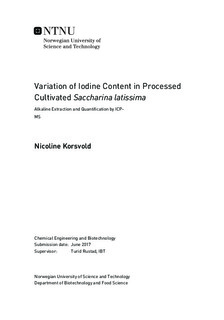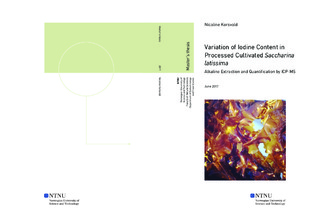| dc.description.abstract | Norway is an established seafood nation, and with the shift to a green economy, macroalgae present themselves as an exciting contributor. Concern has been expressed about the high accumulation of iodine by some brown macroalgal species.
The objective of this study was to develop a process for extracting and quantifying iodine content in rope cultured Saccharina latissima after air-drying, freeze-drying, rehydration and boiling. The samples were provided by Seaweed Energy Solutions from their cultivation site on Frøya.
Three methods were used to digest the biomass and extract iodine from the processed macroalgae: A microwave-assisted alkaline extraction, an oven alkaline extraction, and a nitric acid digestion. The digestion solutions were analysed by ICP-MS. The formation of volatile iodine species at acidic pH makes nitric acid digestion an unreliable method. The oven alkaline extraction was believed to give the most accurate results with the equipment available. Microwave-assisted alkaline extraction is faster, but has a higher demand for advanced laboratory equipment. According to the oven alkaline extraction, the total iodine content of S. latissima harvested in May 2016 and April 2017 was 3802(123) mg/kg and 2930(168)mg/kg on a dry weight basis, respectively.
The goal of preservation and cooking processes is to minimise the loss of beneficial compounds. Macroalgae are rich in polyphenols, which are potent antioxidants. Folin-Ciocalteu's total phenols method was used on acetonic extracts of freeze-dried, rehydrated and boiled macroalgal samples to assess any unwanted loss. Important parameters for the reliability and extraction efficiency were found to be accurate dry weight measurements, incubation time with Folin-Ciocalteu's reagent and storage time starting from sampling of processed macroalgae until spectrophotometric analyses. A standard was prepared with propyl gallate, a synthetic antioxidant with high antioxidant capacity. The phenolic content was found for freeze-dried, rehydrated and boiled S. latissima harvested in May 2016 to be 0.070 - 0.10 mg PGE/g DW. The values were not significantly different (ANOVA, p<0.05).
The remaining water from rehydration and boiling dried S. latissima was evaluated for the extraction potential of fucoidans as a part of a biorefinery process. Fucoidans are a structurally diverse class of polysaccharides that are challenging to quantify directly. Instead, the remaining water was acid hydrolysed to release L-fucose. The boiling water had the highest content at 15.4(0.2) mg/L (5 g macroalgae per 500 mL deionised water), or 1.56(0.02) mg/(g DW). The fucose concentration in the rehydration water was too low to give accurate measurements. Although negative from a biorefinery perspective, it is promising from a nutritional perspective that rehydration does not seem to influence the fucoidan content of the macroalgae. | |

